Research on fossil mako sharks.
| For the purpose of identification of the fossil Mako sharks, the teeth of recent mako sharks are examined accurately. According to the results, in this page , characteristics of recent mako shark teeth and those of fossil mako shark teeth from mainly Japan are shown. |
| 1. Recent |
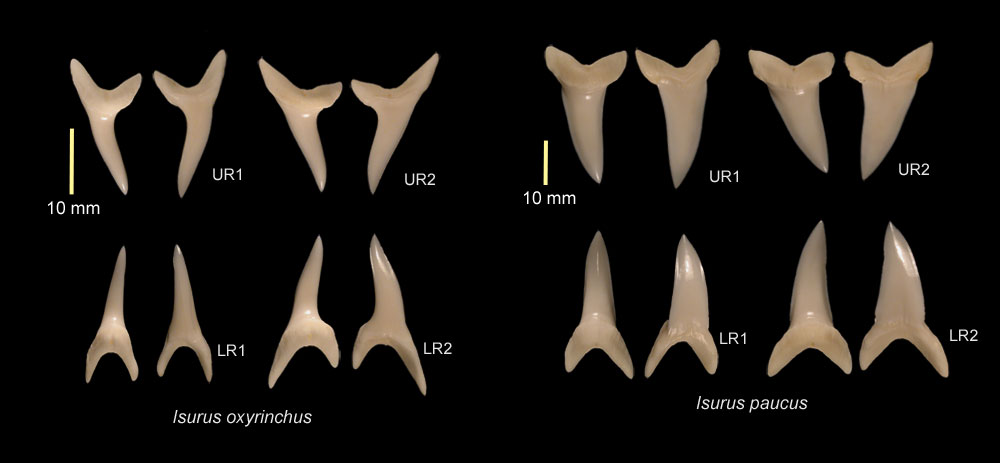
| Fig.1-1. Anterior teeth of recent Mako sharks. |
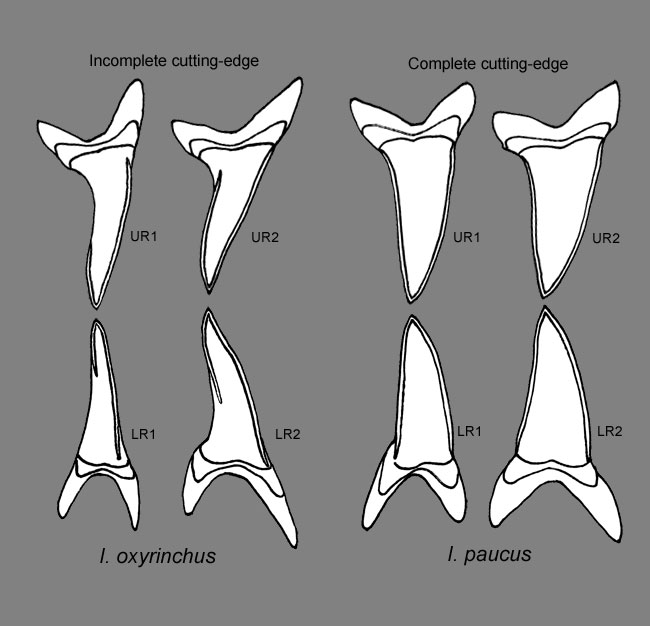
| Fig. 1-2. Cutting-edges of recent mako sharks |
| Each anterior tooth of Isurus oxyrinchus (shortfin mako shark) is different from one another in its contour and cutting-edge. The cuttting-edges are incomplete and the parts lacking in them are
rounded. In Isurus paucus (longfin mako shark), the cusp is wider and thinner than I. oxyrinchus and the cutting-edge is complete. The cusp of Isurus bent strongly toward the rear on the lower tooth, while on the upper tooth
it is almost straight. Most of recent lamnids and odontaspids show almost
the same characteristics on this point. |
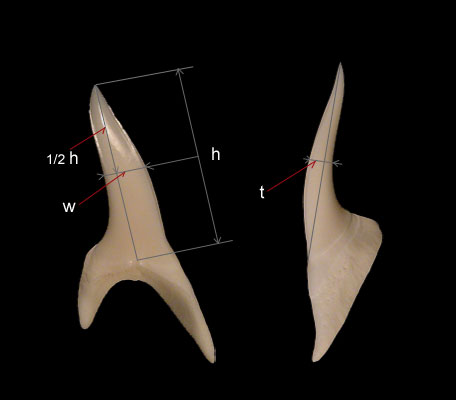  |
| Fig. 1-3. Measurement of the tooth crown and distribution pattern of the tooth proportion. |
| For specifyng the tooth characteristics, height(h), width(w) and thickness(t)
of the selachian's cusp are measured as shown in the left side. Values,
h/w and w/t are calculated as tooth proportions and then plotted as a point
of each tooth in the graph as shown in the right side. |
| 2. Middle Pleistocene, Ichijyuku Formation |
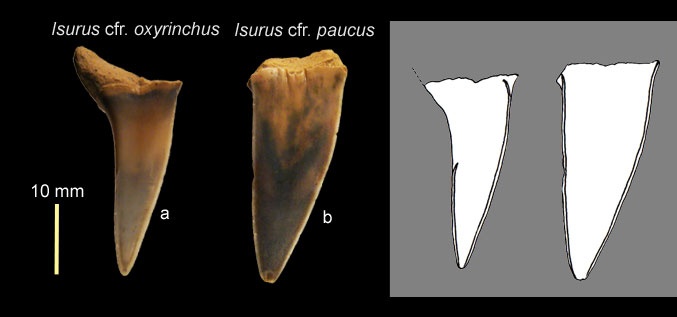
| Fig. 2-1. Two upper teeth from the Pleistocene of the Ichijyuku Formation, Chiba prefecture, Japan and their cutting edges |
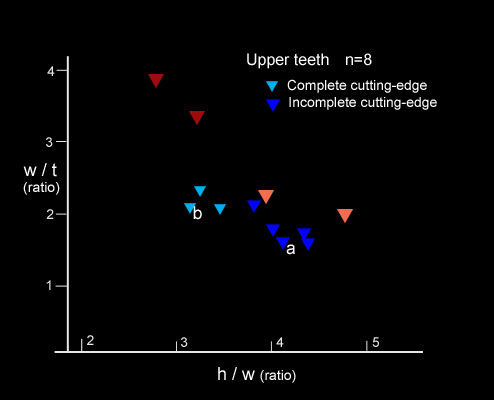 |
| Fig. 2-2. Ditribution pattern of the upper teeth from the Pleistocene of Ichijyuku |
| The teeth of Isurus obtained from Ichijyku, Chiba prefecture show two types of contours, I. cfr. oxirinchus and I. cfr. paucus as shown in Fig. 2-1. However, I. cfr oxirinchus from the sites has longer cutting-edge and thicker tooth than those of recent I. oxirinchus, and the tooth of I. cfr. paucus is also thichker than recent I. paucus. The distributin pattern of the upper teeth also indicate the facts (Fig. 2-2). |
| 3. Pliocene, Naarai F. |

| Fig. 3-1. Specimens from the Pliocene of Naarai F., Chiba prefecture, Japan. |
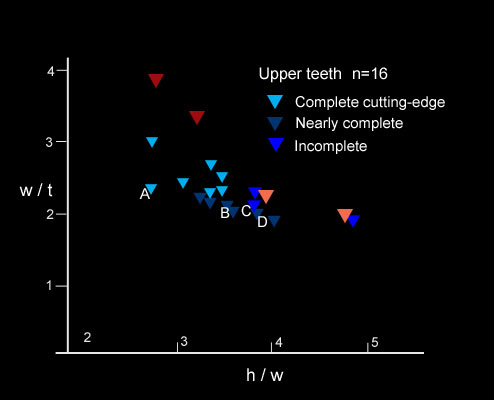
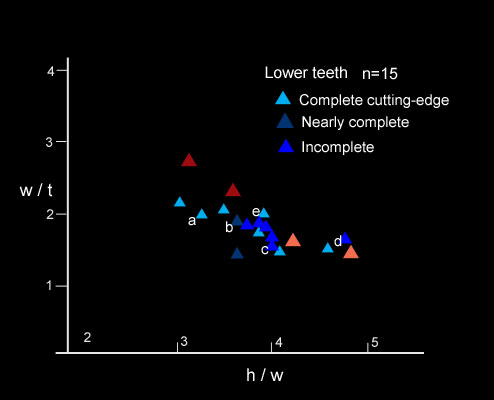
| Fig. 3-2. Distribution patterns of specimens from the Pliocene of Naarai F., Left: upper tooth, Right: lower tooth. |
| Specimens, both upper and lower teeth, from the Pliocene of Naarai F. showed a wide variety of mixed type shapes of Isurus oxyrinchus (the shortfin mako shark) and I. paucus (the longfin mako shark). Fossil teeth of I. paucus type are thicker than those of the modern shark and especially the upper teeth are thicker by 40% on average. Some teeth resemble I. retroflexus in shape. Among the mixed type narrower teeth with incomplete cutting-edge, evolved to bear an elegant shape like as a Janbia dagger, is thought to be the modern shortfin mako shark. |
| 4. Late Miocene, Kyonan, Senhata Formation |
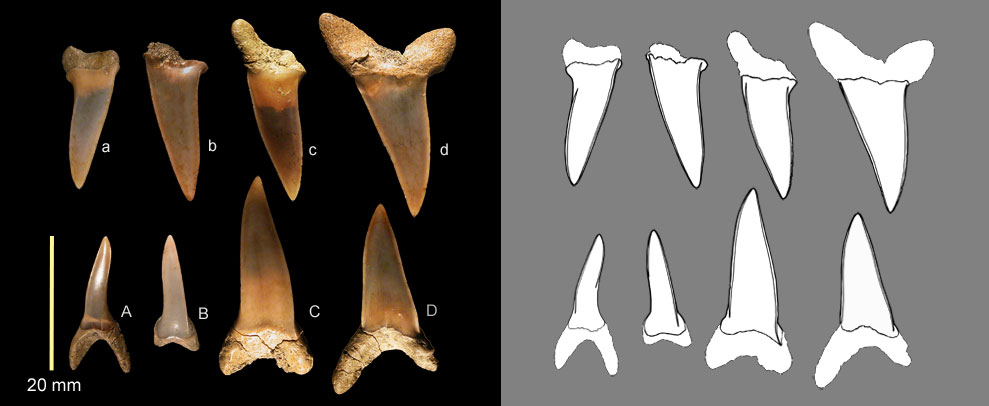
| Fig. 4-1. Specimens from the Late Miocene of Senhata, Chiba prefecture, Japan and their cutting edges |
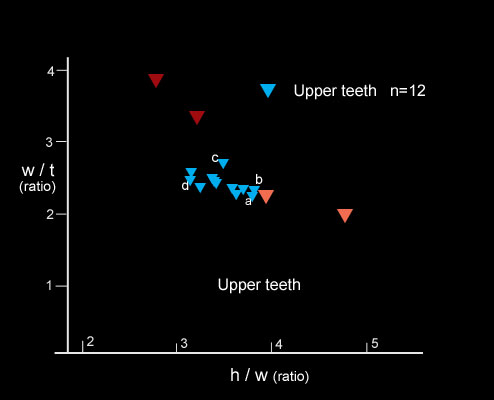

| Fig. 4-2. Distribution patterns of Specimens of Senhata. left, upper teeth; right, lower teeth. |
| The upper shark teeth from the Senhata Formation show the intermediate cusp proportionths between I. oxirinchus and I. paucus (left), while the lower teeth show the wide vareity of cusp propotions which vary from those of I. oxirinchus to I. paucus (right). It seemes to me that the Isurus from the late Miocene of Senhata had just begun to diverge to two species, I. oxirinchus and I. paucus. In this period, however, the upper cusp of the species is thicker than that of recent I. paucus and thinner when compared to recent I. oxirinchus. |
| 5. Early Middle Miocene, Ichisi G. |

| Fig. 5-1. Isurus cf. oxyrhinchus; A: imcomplete cutting-edge, height; 39 mm, B: nearly complete cutting-edge, height; 30 mm |
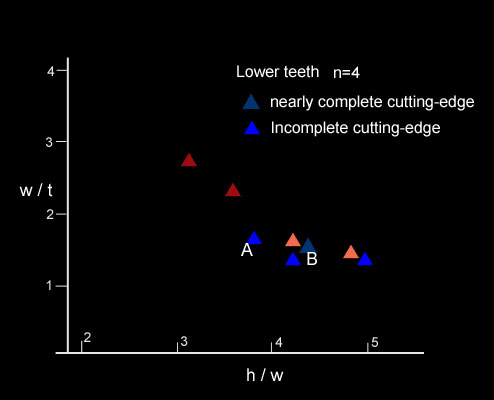
| Fig. 5-2. Distribution pattern of the lower teeth from the Early Middle Miocene of Ichishi G. |
| The lower teeth from the Early Middle Miocene of the Ichisi Formation are large in size and almost symmetrical. They have the shorter cutting-edge than that of recent I. oxyrinchus and show rounded cusp . The proportion pattern of the teeth (Fig. 5-2) shows that these teeth are probably referable to I. oxirinchus with short cutting-edge. |
| 6. Late Oligocene, Ashiya G. |

| Fig. 6-1. an upper tooth from the Oligocene of Ashiya G. Isurus sp.; height; 19 mm, complete cutting-edge.D |
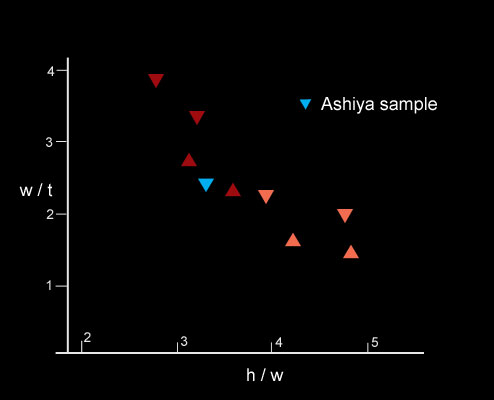
| Fig. 6-2. Distribution pattern of an upper tooth from the Oligocene of Ashiya G. |
| From the late Miocene to the Pliocene, Mako sharks consisted of a wide variety of variants with various tooth shapes and cutting-edges, and had been swimming in the sea. To give the different sharks a different species name (I. oxyrinchus, I. paucus, I.desori, I. retroflexus) is like dividing a rainbow into 3 or 7 different colors. |
| A distribution pattern of fossil Mako sharks and an adaptive radiation of Mako shark |
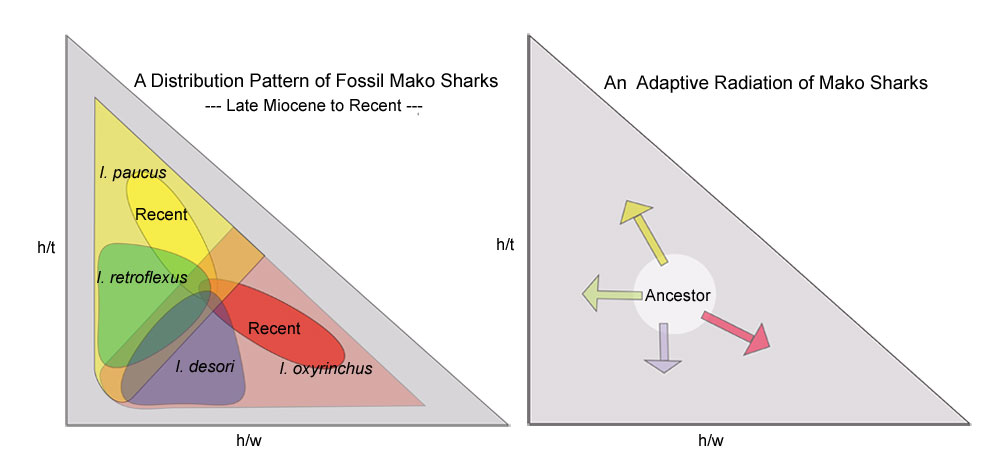
| Fig. 7. Left: Distribution pattern of four fossil species of the Mako shark.
They are not separated from each other. Right: An adaptive radiation of
the Mako shark. |
| Ancestral species |
| Anterior teeth of an ancestor mako shark locate near the center of the distribution pattern (h/w ratio = 3.5, h/t ratio = 2). The first row tooth and the second row tooth of the ancestor mako shark resemble the second row tooth of the longfin makoshark and the first row tooth of the shortfin mako shark, respectively but both teeth are thicker with mesio-distally less curved tooth than those of modern sharks . Cutting-edge of the ancestor shark could be complete or nearly complete. The Eocene species I. precursor probably is close in shape to the ancestor. |
| Appendix |
| Eocene |

| Fig. 8. Specimens from the Eocene of Kert, N. Mangyshlak Peninsula, Vogan, Togo and the Santee Limestone, U.S.A. |
| I. praecursor (Leriche, 1905,1906) and I. americanus are known well as Isurus/Cosmopolitadus from the EoceneD Both species are shown in Fig. 6. for help us in understanding Isurus/Cosmopolitadus. |
ver.1 20091014